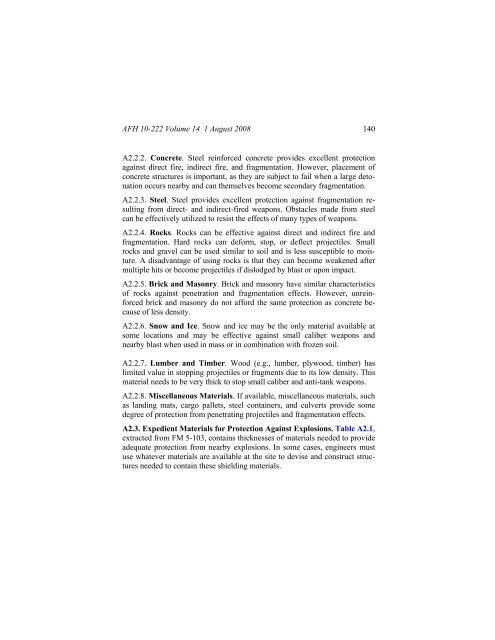Civil engineer guide to fighting positions, shelters, obstacles
Civil engineer guide to fighting positions, shelters, obstacles
Civil engineer guide to fighting positions, shelters, obstacles
Create successful ePaper yourself
Turn your PDF publications into a flip-book with our unique Google optimized e-Paper software.
AFH 10-222 Volume 14 1 August 2008 140<br />
A2.2.2. Concrete. Steel reinforced concrete provides excellent protection<br />
against direct fire, indirect fire, and fragmentation. However, placement of<br />
concrete structures is important, as they are subject <strong>to</strong> fail when a large de<strong>to</strong>nation<br />
occurs nearby and can themselves become secondary fragmentation.<br />
A2.2.3. Steel. Steel provides excellent protection against fragmentation resulting<br />
from direct- and indirect-fired weapons. Obstacles made from steel<br />
can be effectively utilized <strong>to</strong> resist the effects of many types of weapons.<br />
A2.2.4. Rocks. Rocks can be effective against direct and indirect fire and<br />
fragmentation. Hard rocks can deform, s<strong>to</strong>p, or deflect projectiles. Small<br />
rocks and gravel can be used similar <strong>to</strong> soil and is less susceptible <strong>to</strong> moisture.<br />
A disadvantage of using rocks is that they can become weakened after<br />
multiple hits or become projectiles if dislodged by blast or upon impact.<br />
A2.2.5. Brick and Masonry. Brick and masonry have similar characteristics<br />
of rocks against penetration and fragmentation effects. However, unreinforced<br />
brick and masonry do not afford the same protection as concrete because<br />
of less density.<br />
A2.2.6. Snow and Ice. Snow and ice may be the only material available at<br />
some locations and may be effective against small caliber weapons and<br />
nearby blast when used in mass or in combination with frozen soil.<br />
A2.2.7. Lumber and Timber. Wood (e.g., lumber, plywood, timber) has<br />
limited value in s<strong>to</strong>pping projectiles or fragments due <strong>to</strong> its low density. This<br />
material needs <strong>to</strong> be very thick <strong>to</strong> s<strong>to</strong>p small caliber and anti-tank weapons.<br />
A2.2.8. Miscellaneous Materials. If available, miscellaneous materials, such<br />
as landing mats, cargo pallets, steel containers, and culverts provide some<br />
degree of protection from penetrating projectiles and fragmentation effects.<br />
A2.3. Expedient Materials for Protection Against Explosions. Table A2.1,<br />
extracted from FM 5-103, contains thicknesses of materials needed <strong>to</strong> provide<br />
adequate protection from nearby explosions. In some cases, <strong>engineer</strong>s must<br />
use whatever materials are available at the site <strong>to</strong> devise and construct structures<br />
needed <strong>to</strong> contain these shielding materials.
















